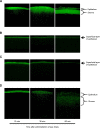Positively charged micelles based on a triblock copolymer demonstrate enhanced corneal penetration
- PMID: 26451109
- PMCID: PMC4592048
- DOI: 10.2147/IJN.S90347
Positively charged micelles based on a triblock copolymer demonstrate enhanced corneal penetration
Abstract
Purpose: The cornea is a main barrier to drug penetration after topical application. The aim of this study was to evaluate the abilities of micelles generated from a positively charged triblock copolymer to penetrate the cornea after topical application.
Methods: The triblock copolymer poly(ethylene glycol)-poly(ε-caprolactone)-g-polyethyleneimine was synthesized, and the physicochemical properties of the self-assembled polymeric micelles were investigated, including hydrodynamic size, zeta potential, morphology, drug-loading content, drug-loading efficiency, and in vitro drug release. Using fluorescein diacetate as a model drug, the penetration capabilities of the polymeric micelles were monitored in vivo using a two-photon scanning fluorescence microscopy on murine corneas after topical application.
Results: The polymer was successfully synthesized and confirmed using nuclear magnetic resonance and Fourier transform infrared. The polymeric micelles had an average particle size of 28 nm, a zeta potential of approximately +12 mV, and a spherical morphology. The drug-loading efficiency and drug-loading content were 75.37% and 3.47%, respectively, which indicates that the polymeric micelles possess a high drug-loading capacity. The polymeric micelles also exhibited controlled-release behavior in vitro. Compared to the control, the positively charged polymeric micelles significantly penetrated through the cornea.
Conclusion: Positively charged micelles generated from a triblock copolymer are a promising vehicle for the topical delivery of hydrophobic agents in ocular applications.
Keywords: controlled release; corneal barriers; corneal penetration; polymeric micelles; topical administration.
Figures






Similar articles
-
pH-sensitive micelles self-assembled from polymer brush (PAE-g-cholesterol)-b-PEG-b-(PAE-g-cholesterol) for anticancer drug delivery and controlled release.Int J Nanomedicine. 2017 Mar 21;12:2215-2226. doi: 10.2147/IJN.S130037. eCollection 2017. Int J Nanomedicine. 2017. PMID: 28356738 Free PMC article.
-
Supramolecular assembly of poly(β-cyclodextrin) block copolymer and benzimidazole-poly(ε-caprolactone) based on host-guest recognition for drug delivery.Colloids Surf B Biointerfaces. 2017 Dec 1;160:364-371. doi: 10.1016/j.colsurfb.2017.09.047. Epub 2017 Sep 22. Colloids Surf B Biointerfaces. 2017. PMID: 28963957
-
Self-assembled honokiol-loaded micelles based on poly(epsilon-caprolactone)-poly(ethylene glycol)-poly(epsilon-caprolactone) copolymer.Int J Pharm. 2009 Mar 18;369(1-2):170-5. doi: 10.1016/j.ijpharm.2008.10.027. Epub 2008 Nov 5. Int J Pharm. 2009. PMID: 19028556
-
Role of Polymeric Micelles in Ocular Drug Delivery: An Overview of Decades of Research.Mol Pharm. 2023 Nov 6;20(11):5359-5382. doi: 10.1021/acs.molpharmaceut.3c00598. Epub 2023 Sep 28. Mol Pharm. 2023. PMID: 37769017 Review.
-
Topical application of polymeric nanomicelles in ophthalmology: a review on research efforts for the noninvasive delivery of ocular therapeutics.Expert Opin Drug Deliv. 2019 Apr;16(4):397-413. doi: 10.1080/17425247.2019.1597848. Epub 2019 Apr 8. Expert Opin Drug Deliv. 2019. PMID: 30889977 Review.
Cited by
-
Ocular delivery of proteins and peptides: Challenges and novel formulation approaches.Adv Drug Deliv Rev. 2018 Feb 15;126:67-95. doi: 10.1016/j.addr.2018.01.008. Epub 2018 Jan 13. Adv Drug Deliv Rev. 2018. PMID: 29339145 Free PMC article. Review.
-
Effect of PEGylation on assembly morphology and cellular uptake of poly ethyleneimine-cholesterol conjugates for delivery of sorafenib tosylate in hepatocellular carcinoma.Bioimpacts. 2018;8(4):241-252. doi: 10.15171/bi.2018.27. Epub 2018 Apr 18. Bioimpacts. 2018. PMID: 30397579 Free PMC article.
-
Celastrol-based nanomedicine promotes corneal allograft survival.J Nanobiotechnology. 2021 Oct 26;19(1):341. doi: 10.1186/s12951-021-01079-w. J Nanobiotechnology. 2021. PMID: 34702273 Free PMC article.
-
Ophthalmic In Situ Gelling System Containing Lanosterol Nanoparticles Delays Collapse of Lens Structure in Shumiya Cataract Rats.Pharmaceutics. 2020 Jul 4;12(7):629. doi: 10.3390/pharmaceutics12070629. Pharmaceutics. 2020. PMID: 32635523 Free PMC article.
-
In Situ Gelling Systems Using Pluronic F127 Enhance Corneal Permeability of Indomethacin Nanocrystals.Int J Mol Sci. 2020 Sep 25;21(19):7083. doi: 10.3390/ijms21197083. Int J Mol Sci. 2020. PMID: 32992931 Free PMC article.
References
-
- Ali Y, Lehmussaari K. Industrial perspective in ocular drug delivery. Adv Drug Deliv Rev. 2006;58(11):1258–1268. - PubMed
-
- Yang J, Yan J, Zhou Z, Amsden BG. Dithiol-PEG-PDLLA micelles: preparation and evaluation as potential topical ocular delivery vehicle. Biomacromolecules. 2014;15(4):1346–1354. - PubMed
-
- Shirasaki Y. Molecular design for enhancement of ocular penetration. J Pharm Sci. 2008;97(7):2462–2496. - PubMed
-
- Mishima S. Clinical pharmacokinetics of the eye. Proctor lecture. Invest Ophthalmol Vis Sci. 1981;21(4):504–541. - PubMed
Publication types
MeSH terms
Substances
LinkOut - more resources
Full Text Sources
Other Literature Sources

